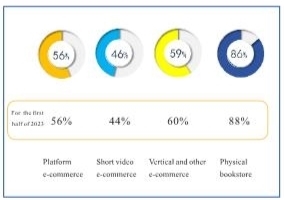According to the data from Beijing OpenBook Co., Ltd., in the first half of 2024, the overall retail market in China continued to experience negative growth, and the “heavily discounted price war” continued. It has become common for publishing houses to rely on multi-channel sales. The trend of best-sellers is shifting from mass appeal to niche markets, with varied rankings in different retail channels.
Year-on-year growth rate of the print sales value by the list price of China’s book retail market in the first half of 2024:
-6.20%
Year-on-year growth rate of China’s retail book market across various channels:
Book discount rates for different channels:
Retail platforms compete with low prices and offer discounts to attract readers’ attention, while short video e-commerce channel owns the lowest discounts.
Book buyers and reasons for purchase differentiated by retail channel evolution:
There are more and more types of e-commerce platforms such as vertical e-commerce, platform e-commerce, content e-commerce, interest e-commerce, and community e-commerce, with different user profiles on different platforms.
Highlights of different book categories
Study aids, Lifestyle, Language, and Natural science books have achieved counter-trend growth in sales revenue by the list price.
Children’s books have the highest proportion, while Study aids books have the largest year-on-year increase in market share (percentage of market share in sales by market value).
Year-on-year changes in the proportion of the top 5 sub-categories in retail across different channels
Hit and best-selling trends
①Different sales logic shows different characteristics of bestseller lists. In the list of fictional books, “books on shelves” has more classic books, “interest-driven” prefer public domain books.
②The recent hit TV series To the Wonder aroused wide attention, leading to a surge in the sales of its book My Altay.
③The trend of “manga+” continues, with book themes relating to Murphy’s Law, psychology, think tank, legal enlightenment, etc.
④Keywords such as “new quality productivity”, “company wealth and management”, and “emotional value” attract attention widely.














